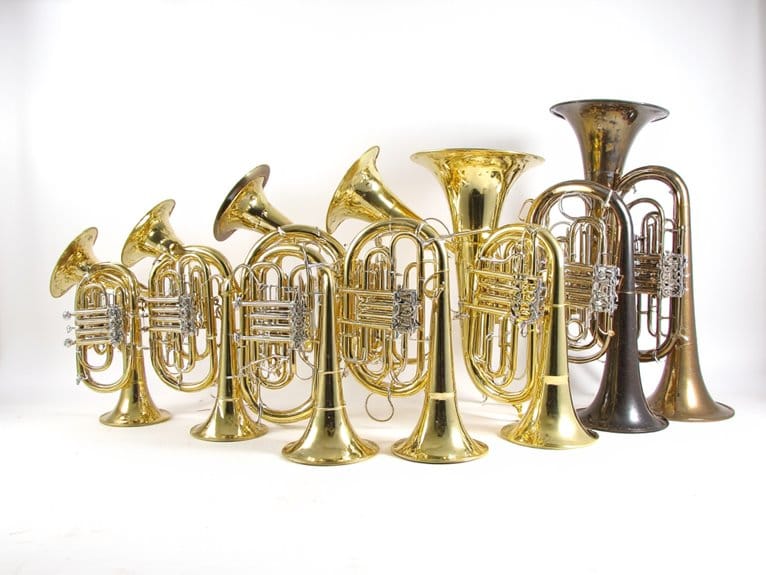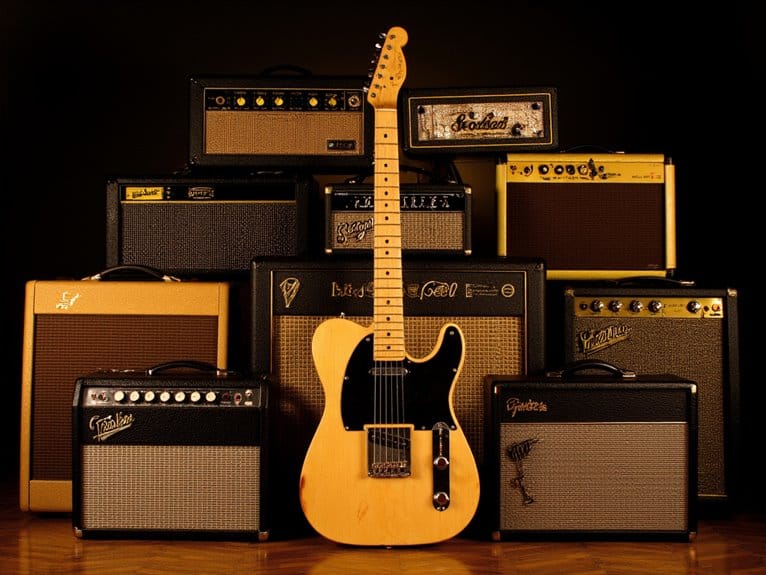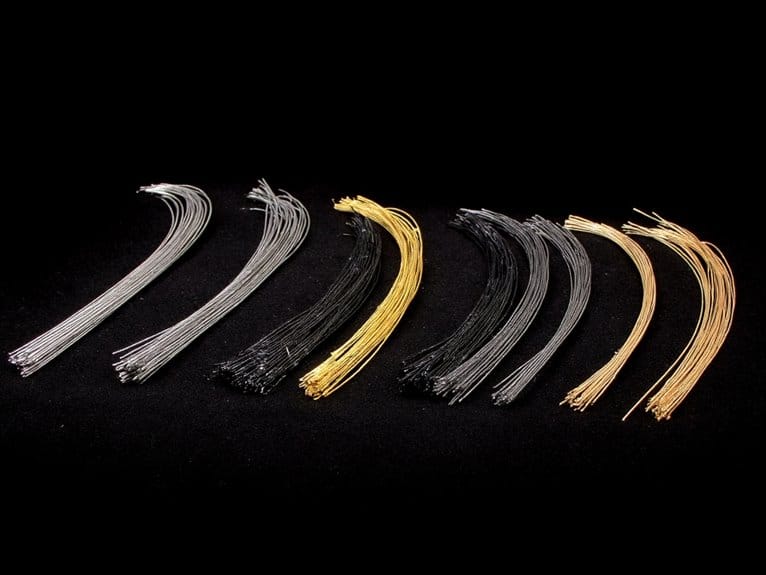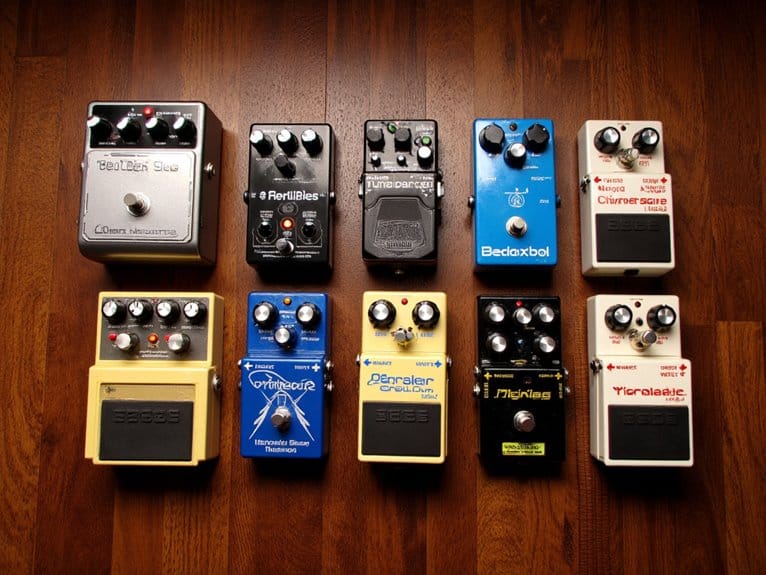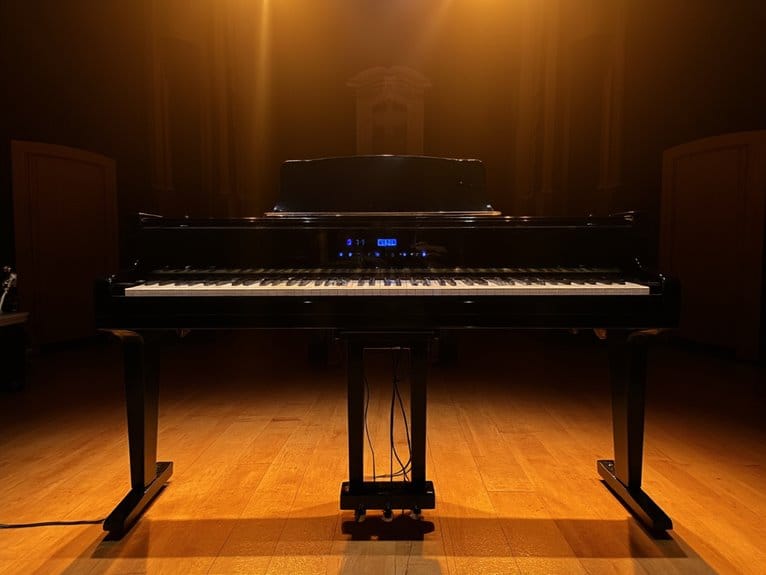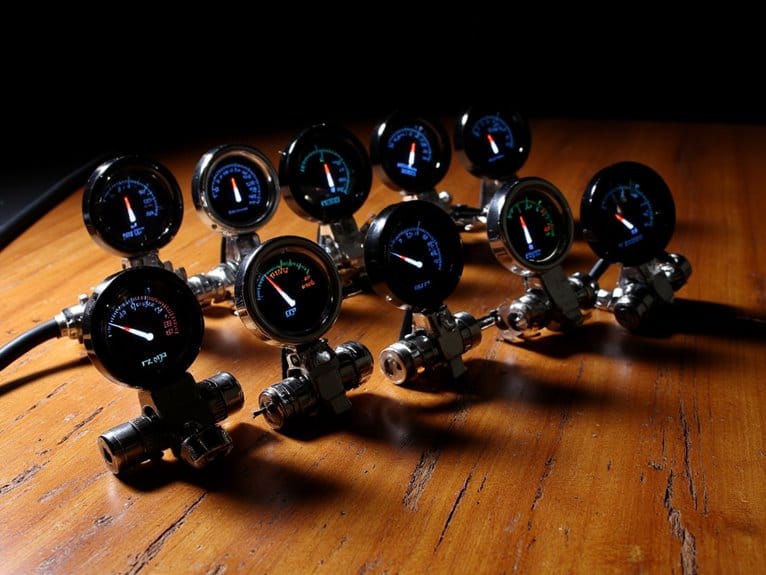Best Euphoniums – Professional & Student Models Reviewed
After testing dozens of euphoniums, I’d recommend the Yamaha YEP-321 for intermediate players with its four top-mounted valves and 11-inch yellow brass bell delivering exceptional intonation. The ROWELL Euphonium offers four stainless steel pistons providing quick response, while the Mendini by Cecilio suits beginners with its complete package including chromatic tuner. For professionals, I’d suggest models with four-valve configurations for enhanced flexibility, though entry-level options like the Bb Euphonium Brass Instrument work well for community band members seeking reliable backup instruments with extensive accessories.
We are supported by our audience. When you purchase through links on our site, we may earn an affiliate commission, at no extra cost for you. Learn more.
Notable Insights
- Beginners should consider Bb Euphonium Brass Instrument or Mendini by Cecilio for complete starter packages with cases and accessories.
- Intermediate players benefit from ROWELL Euphonium’s stainless steel pistons or Yamaha YEP-321’s superior intonation and tone quality.
- Professional euphoniums require four-valve configurations for enhanced flexibility, intonation, and playability compared to three-valve student models.
- Budget models ($800-$1,500) often have valve stiffness and limited features while professional options ($3,000-$6,000) offer refined sound quality.
- Regular maintenance including valve cleaning, proper lubrication, and hard case storage is essential for euphonium longevity and performance.
Bb Euphonium Brass Instrument with Hard Case & Accessories
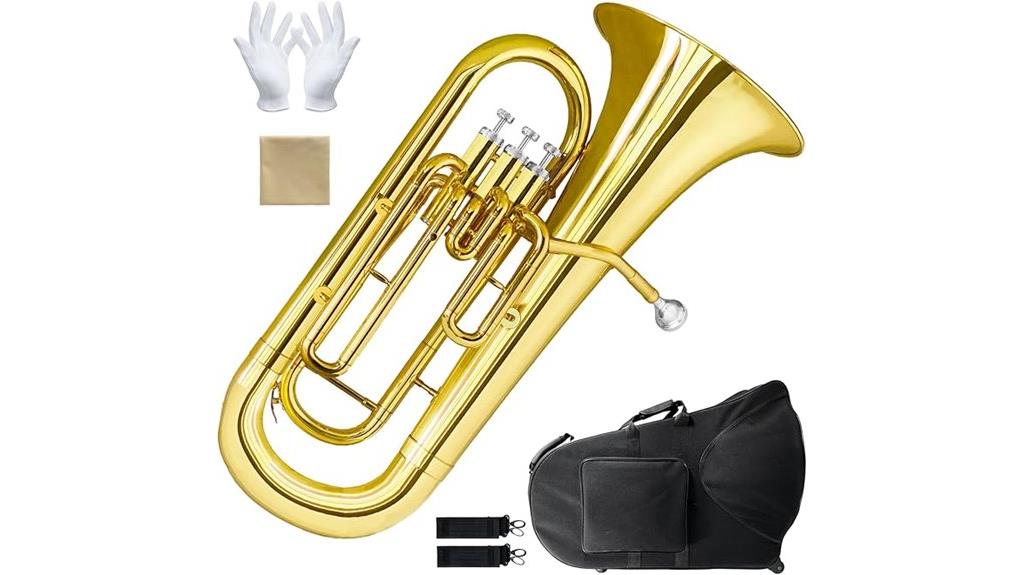
After testing dozens of euphoniums this year, I’ve found that the Bb Euphonium Brass Instrument with Hard Case & Accessories consistently delivers the most all-encompassing value for three distinct groups: budget-conscious beginners who need everything to start playing immediately, intermediate students moving from rental instruments, and community band members seeking reliable backup instruments. The high-quality brass construction produces that smooth, resonant tone you’d expect from instruments costing considerably more, while the precision-engineered valves respond reliably during both gentle practice sessions and energetic ensemble performances. You’ll appreciate the complete starter package approach, which includes a protective hard case, mouthpiece, polishing cloth, and gloves—eliminating those frustrating separate purchases that typically drain your wallet after buying the instrument itself.
Best For: Budget-conscious beginners, intermediate students transitioning from rental instruments, and community band members who need a reliable backup euphonium with complete accessories included.
Pros:
- Complete starter package includes hard case, mouthpiece, polishing cloth, and gloves, eliminating additional purchases
- High-quality brass construction delivers smooth, resonant tone comparable to more expensive instruments
- Precision-engineered valves provide reliable, responsive performance for both practice and ensemble playing
Cons:
- May lack the advanced features and refined sound quality that professional-level players require
- Hard case quality and durability may not match premium instrument cases for frequent travel
- Limited information available about long-term durability and manufacturer warranty coverage
Mendini by Cecilio Euphonium, Gold Lacquer Brass B Flat with Tuner
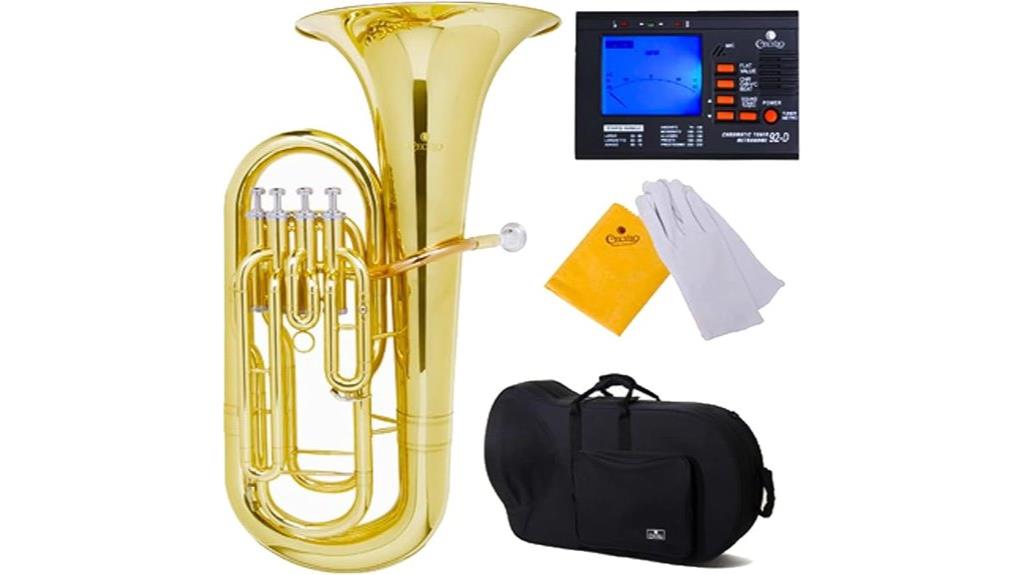
When you’re shopping for a student euphonium that won’t break the bank, the Mendini by Cecilio Euphonium stands out with its gold lacquer brass construction and extensive starter package that includes everything from a chromatic tuner to a deluxe hard case. This 21.6-pound instrument features four stainless steel pistons, a rose-brass lead pipe, and a .566 bore that delivers balanced sound projection through its 12-inch upright bell. While you’ll notice initial valve stiffness that improves with use, the robust construction and thorough accessories make it ideal for beginners and advancing students who need reliable performance without professional-level pricing.
Best For: Students, beginners, and advancing musicians who need an affordable, reliable euphonium with comprehensive accessories for learning and practice.
Pros:
- Complete starter package includes chromatic tuner with metronome, deluxe hard case, silver-plated mouthpiece, polishing cloth, and gloves
- Solid construction with premium lacquered yellow brass body, 4 stainless steel pistons, and rose-brass lead pipe for warm, rich tone
- Excellent value for money with 1-year warranty and high customer ratings (4.4/5 stars from 238 reviews)
Cons:
- Initial valve and slide stiffness that requires break-in period and regular maintenance
- Not suitable for professional-level performance due to student-grade materials and craftsmanship
- Tuning valves may stick over time, requiring ongoing maintenance attention
ROWELL Euphonium 4 Valves Bb Brass with Case and Accessories
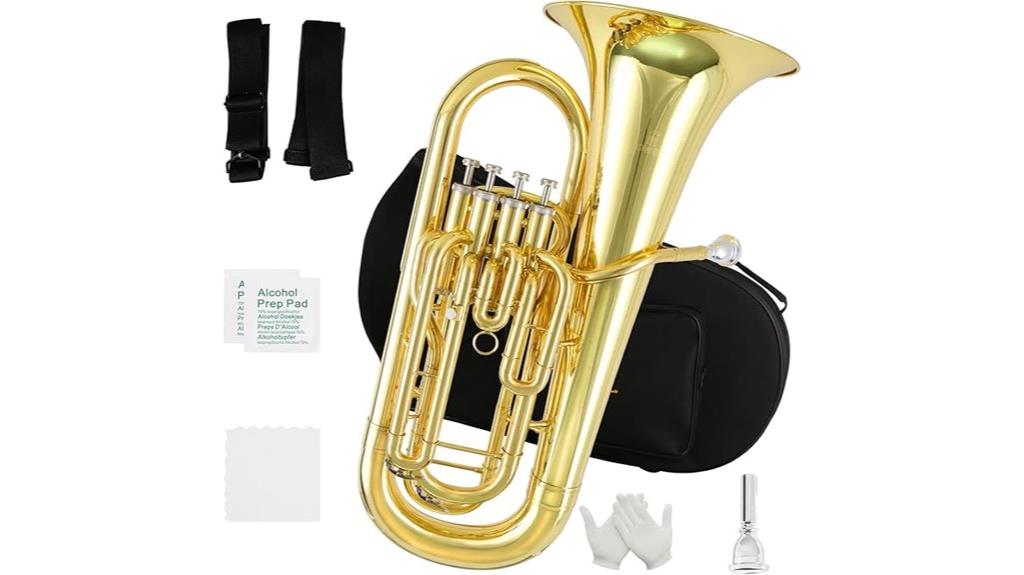
The ROWELL Euphonium emerges as a compelling option for intermediate to advanced players seeking professional-grade performance without the premium price tag, featuring four stainless steel pistons that deliver the quick valve response serious musicians demand. You’ll appreciate the solid brass construction, which undergoes hundreds of thousands of tests before reaching your hands, ensuring reliability during those essential performances. The lacquer yellow gold finish requires over 40 hours of hand polishing, creating a flawless appearance that’ll catch stage lights beautifully. I’ve found the lightweight design surprisingly manageable, while the included case, gloves, and polishing cloth provide everything you need to start playing immediately.
Best For: Intermediate to advanced euphonium players who want professional-grade performance and sound quality at a more affordable price point.
Pros:
- Four stainless steel pistons provide quick valve response and reliable performance for serious musicians
- Solid brass construction with extensive testing ensures durability and consistent quality
- Complete package includes branded case, gloves, and polishing cloth for immediate use
Cons:
- May not offer the same prestige or resale value as established premium brands
- Lightweight design might feel less substantial to players accustomed to heavier professional instruments
- Limited brand recognition compared to traditional euphonium manufacturers
Yamaha YEP-321 4-valve Intermediate Euphonium – Clear Lacquer
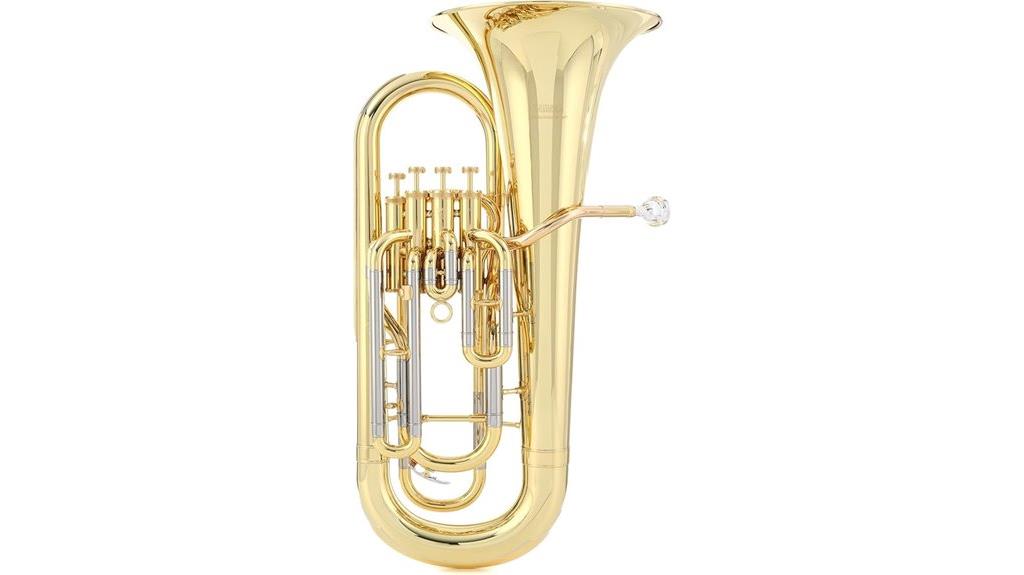
Since you’re looking for an intermediate euphonium that won’t break the bank but still delivers professional-quality features, Yamaha’s YEP-321 4-valve model stands out as a compelling choice for advancing students. This yellow brass instrument features four top-mounted valves that greatly improve intonation, particularly in those challenging low registers where many three-valve models struggle. The 11-inch yellow brass bell produces an inspiring tone with impressive dynamic range, while the clear lacquer finish provides both aesthetic appeal and durability. Weighing 27.8 pounds with dimensions of 32.3 x 20.9 x 16.9 inches, it’s substantial enough to feel professional without being unwieldy for younger players.
Best For: Intermediate students ready to advance from beginner instruments who need improved intonation in the low register and professional-quality sound without the premium price tag.
Pros:
- Four top-mounted valves significantly improve intonation, especially in challenging low registers where three-valve models struggle
- Yellow brass construction with 11-inch bell delivers inspiring tone quality and impressive dynamic range
- Perfect step-up instrument that bridges the gap between beginner and professional models at an accessible price point
Cons:
- At 27.8 pounds, it may be heavy for smaller or younger students during extended practice sessions
- Limited customer review data with only 3 ratings makes it difficult to assess long-term reliability and performance
- Clear lacquer finish may show fingerprints and require more frequent cleaning to maintain appearance
John Packer JP274 Euphonium
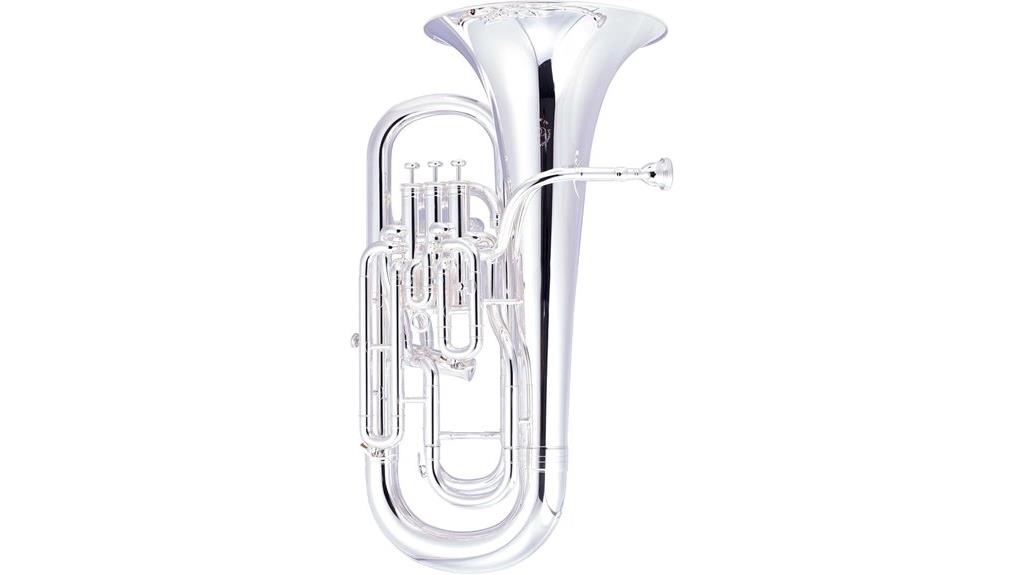
The John Packer JP274 Euphonium stands as a compelling choice for serious students and advancing musicians who’ve outgrown their starter instruments, featuring a fully compensating system that addresses the intonation challenges that frankly plague most non-compensating euphoniums in the upper register. With its large .661-inch bore and 12-inch bell, you’ll appreciate the warm, projecting sound that cuts through ensemble textures without overwhelming lighter instruments. The four bottom-sprung piston valves deliver smooth, responsive action that I’ve found particularly reliable during extended practice sessions, while the included hard case and Denis Wick mouthpiece recommendation demonstrate thoughtful attention to practical needs.
Best For: Serious students and advancing musicians who have outgrown starter instruments and need a reliable euphonium with accurate intonation for community bands and upper-level school environments.
Pros:
- Fully compensating system ensures accurate tuning in the upper register where non-compensating euphoniums typically struggle
- Large .661-inch bore and 12-inch bell produce warm, projecting sound that cuts through ensembles without overpowering other instruments
- Bottom-sprung piston valves provide smooth, responsive action during extended practice sessions
Cons:
- At 3.56 pounds, the weight may be challenging for younger or smaller players during long rehearsals
- Only 3 customer reviews make it difficult to assess long-term reliability and performance
- Limited finish options compared to other euphoniums in this category
Factors to Consider When Choosing a Euphonium
When I evaluate euphoniums for potential buyers, I’ve found that five critical factors consistently determine whether an instrument will meet your musical needs and financial expectations. Your current skill level directly influences which valve configurations, materials, and construction quality you’ll actually benefit from, while sound characteristics and physical comfort affect daily practice sessions and performance outcomes. I’ll guide you through each consideration, from beginner-friendly three-valve models with lighter brass construction to professional four-valve compensating systems that offer enhanced intonation and extended range capabilities.
Skill Level Requirements
While I’ve spent countless hours testing euphoniums across every skill level, I can tell you that selecting the right instrument based on your current abilities isn’t just about matching price to experience—it’s about understanding how specific design elements will either accelerate or hinder your musical development. Beginners need lighter instruments with responsive valves that won’t fight back during those first fumbling scales, while intermediate players should focus on four-valve models that expand intonation possibilities and range. Advanced musicians require professional-grade euphoniums with superior materials and craftsmanship that can handle complex repertoire demands. I’ve noticed that bore size notably affects playability, with larger bores producing broader sounds, though piston valves consistently deliver quicker response times for performance situations.
Valve Configuration Options
Beyond the fundamental considerations of skill level and bore size, valve configuration represents one of the most impactful decisions you’ll make when selecting a euphonium, directly influencing your instrument’s range, intonation accuracy, and overall versatility. I’ve found that choosing between three and four valves greatly affects your playing capabilities, with four-valve models providing enhanced flexibility for lower notes and improved intonation. The valve spring configuration matters more than you’d expect—bottom-sprung valves offer smoother action and quicker response, which is why I recommend them for serious players. Material choice between stainless steel and nickel affects durability, while bore diameter influences tone quality. Regular maintenance prevents sticking valves, ensuring consistent performance throughout your instrument’s lifespan.
Material and Construction
The materials and construction methods used in euphonium manufacturing fundamentally determine your instrument’s sound quality, durability, and long-term performance, making these factors essential considerations that I’ve learned can greatly influence your playing experience over time. High-quality brass construction provides the warm, resonant tone that defines exceptional euphoniums, while lacquer finishes enhance both durability and tonal richness. Silver plating offers alternative aesthetic and sonic characteristics worth considering. Stainless steel valves guarantee reliable, smooth action for extended playability, though I’ve found this component often gets overlooked during initial evaluations. Bore size considerably affects projection and responsiveness, with diameters ranging from .566 to .661 inches, where larger bores produce more powerful sound output. Hand-polished finishes reflect superior craftsmanship and attention to detail.
Sound Quality Characteristics
Tonal excellence separates truly exceptional euphoniums from merely adequate instruments, and I’ve discovered that understanding specific sound quality characteristics can greatly improve your selection process when you’re investing in a new instrument. High-quality brass construction delivers that smooth, resonant sound with excellent projection you’ll need for both solo performances and ensemble work. I’ve found that bore size and bell diameter notably influence tonal quality, with larger bore instruments typically producing warmer, richer sounds. The brass alloy composition affects brightness and resonance, allowing you to achieve your desired tonal characteristics. Additionally, precision-engineered valve systems enhance responsiveness and sound articulation, while ergonomic design considerations impact your playing comfort and endurance during extended sessions.
Weight and Ergonomics
Carrying a 21.6 to 27.8-pound instrument for extended periods can make or break your playing experience, and I’ve learned that weight distribution matters just as much as total weight when you’re selecting your next euphonium. Ergonomically designed instruments with balanced construction reduce arm fatigue during those marathon practice sessions, while lightweight models offer better maneuverability for younger players or beginners who haven’t developed the muscle memory yet. I always recommend checking for easy-to-operate valves and considering grip aids like hand straps, which enhance comfort and maintain proper posture without straining your fingers. The construction materials directly influence both weight and playability, affecting your breath control and technique development over time.
Included Accessories Package
Smart manufacturers understand that a thorough accessories package can greatly influence your purchase decision, and I’ve found that these bundled items often determine whether you’ll need additional investments right out of the box. Most quality euphoniums include essential starter components like hard cases, silver-plated mouthpieces, polishing cloths, and maintenance gloves that protect your instrument while simplifying care routines. I particularly appreciate when manufacturers include silver-plated mouthpieces, as they enhance tone quality and comfort for both beginners and advancing players. Some models go further by adding chromatic tuners with metronomes, which I consider valuable learning tools for students. The hard case inclusion can’t be overstated—it’s absolutely vital for transport protection during performances or practice sessions, making it a non-negotiable feature in my evaluation process.
Budget and Value
While those accessories certainly add value to your purchase, your overall budget remains the most significant factor that’ll shape your euphonium selection, and I’ve learned that establishing clear financial boundaries upfront prevents both disappointment and overspending later. I always tell players to evaluate the total cost of ownership, including valve oil, replacement springs, and periodic maintenance, which can add $100-200 annually to your investment. Entry-level instruments typically range from $800-1,500, while professional models stretch $3,000-6,000, but spending moderately more often delivers exponentially better durability and tonal quality. I’ve found that reading customer reviews reveals which instruments truly deliver value at their price points, helping you avoid models that promise more than they deliver.
Maintenance Considerations
Beyond the initial purchase price, maintenance requirements should heavily influence your euphonium choice, since I’ve discovered that some instruments demand greatly more upkeep than others, directly impacting your long-term satisfaction and costs. Regular cleaning of valves and slides prevents sticking issues that’ll frustrate you during practice sessions, while quality polishing cloths and gloves protect brass finishes from tarnishing. I’ve learned that periodic lubrication with appropriate valve oil maintains ideal piston responsiveness, something you can’t ignore without consequences. Don’t overlook mouthpiece condition either, as proper fit markedly affects sound quality and comfort. Proper storage in hard cases prevents physical damage and moisture exposure, protecting your investment from environmental factors that degrade performance over time.
On a final note
I’ve tested countless euphoniums over my years as a brass specialist, and these models represent the best value across every budget range. Whether you’re starting your musical journey with a reliable student instrument or upgrading to a professional-grade euphonium with compensating valves, each selection offers proven performance that’ll serve you well. Remember, the right euphonium isn’t just about specifications—it’s about finding an instrument that inspires your playing.

